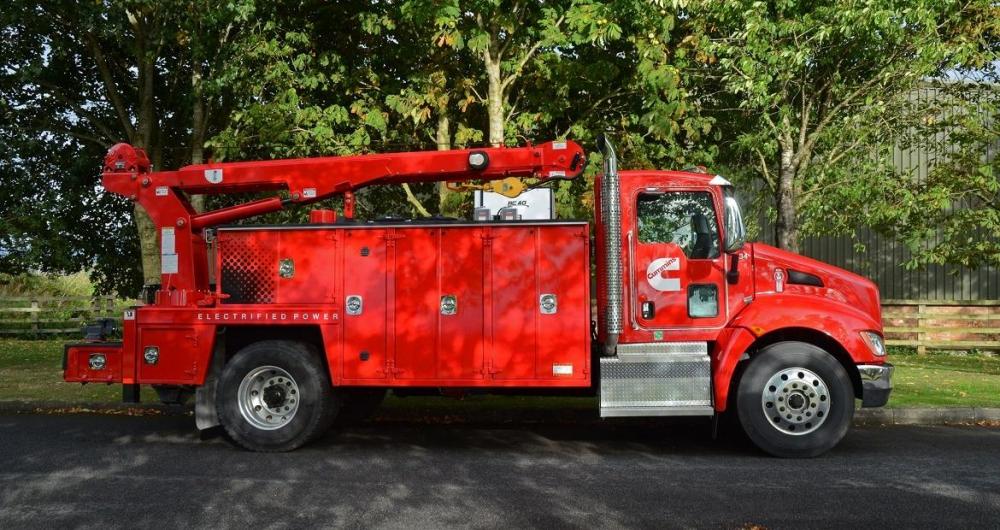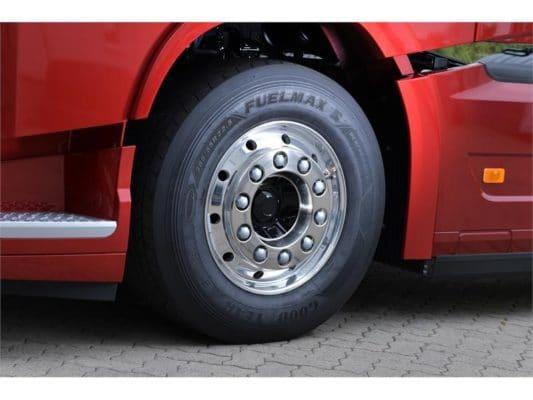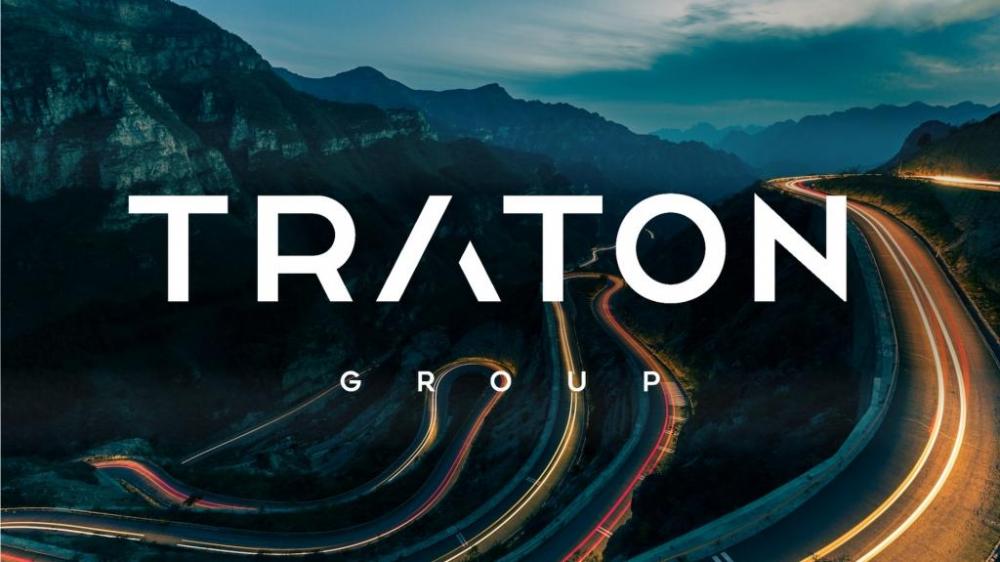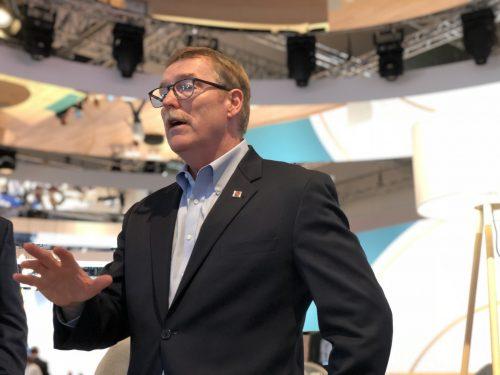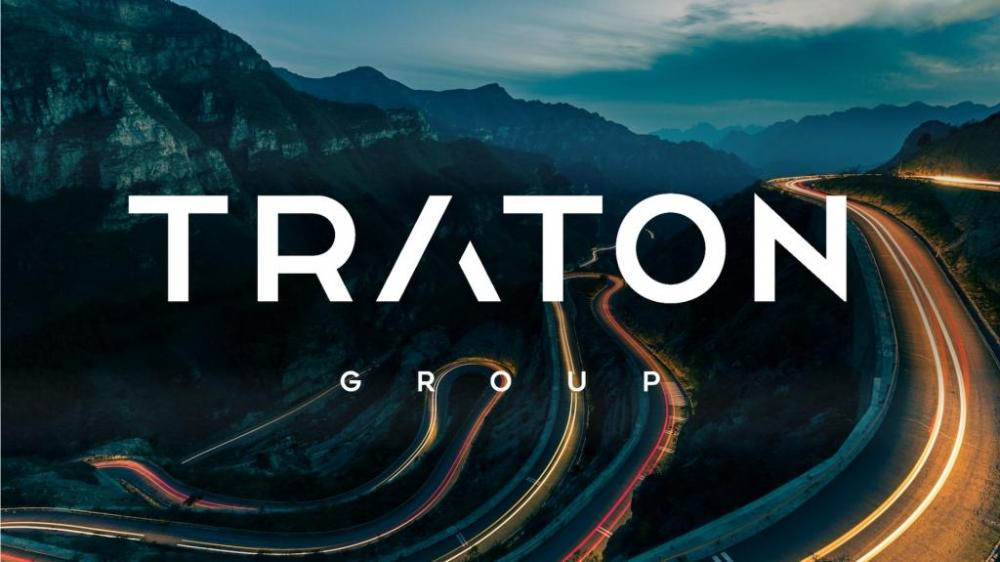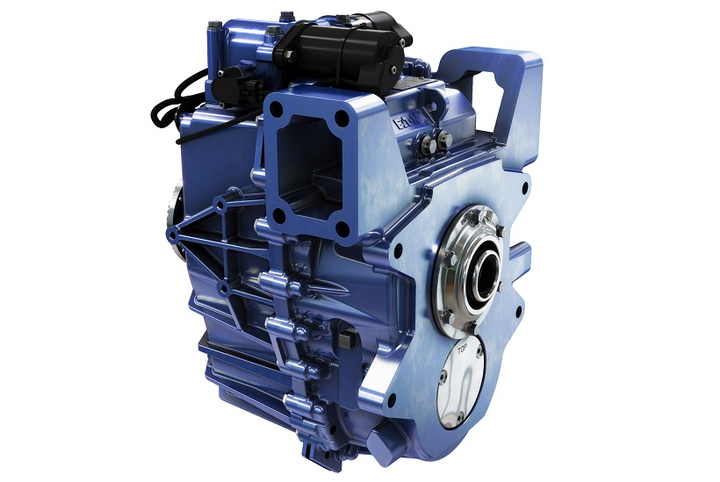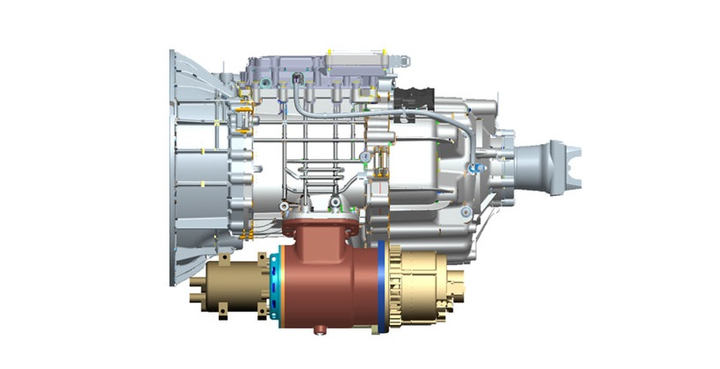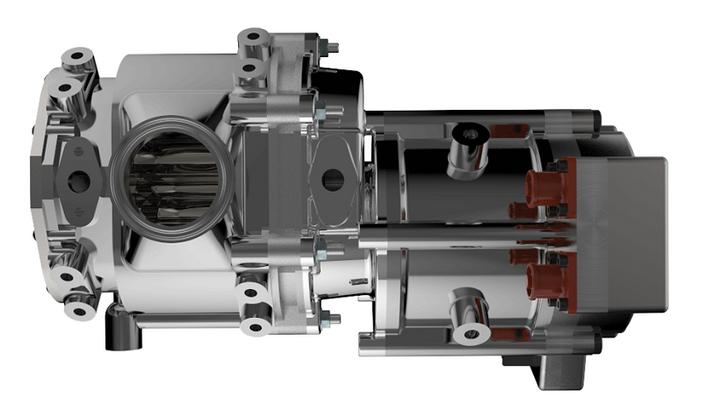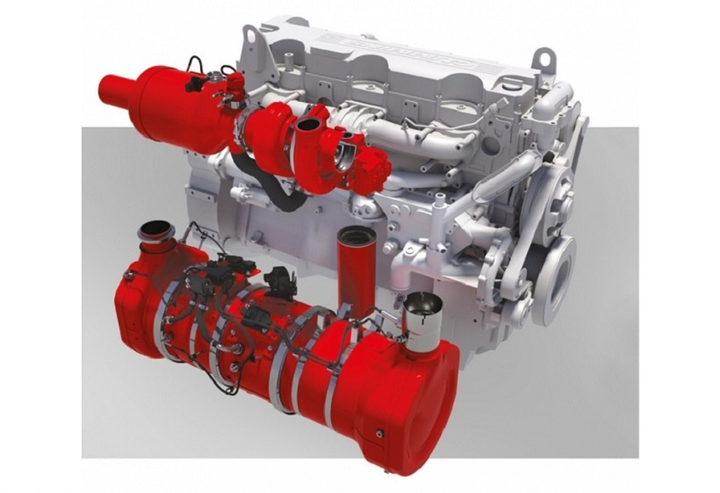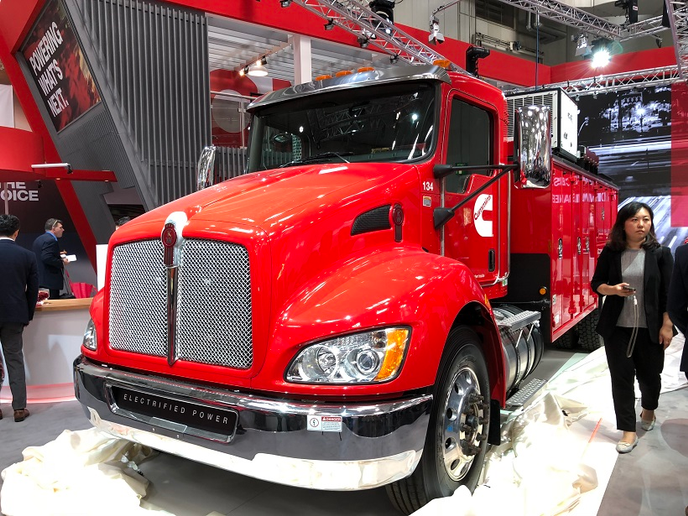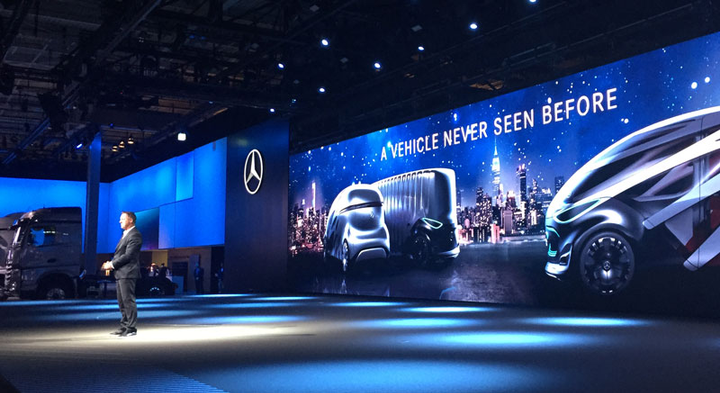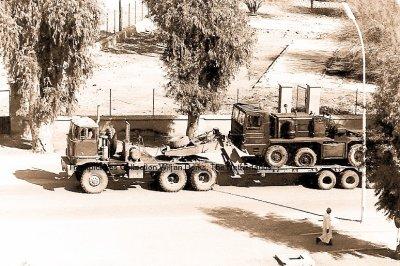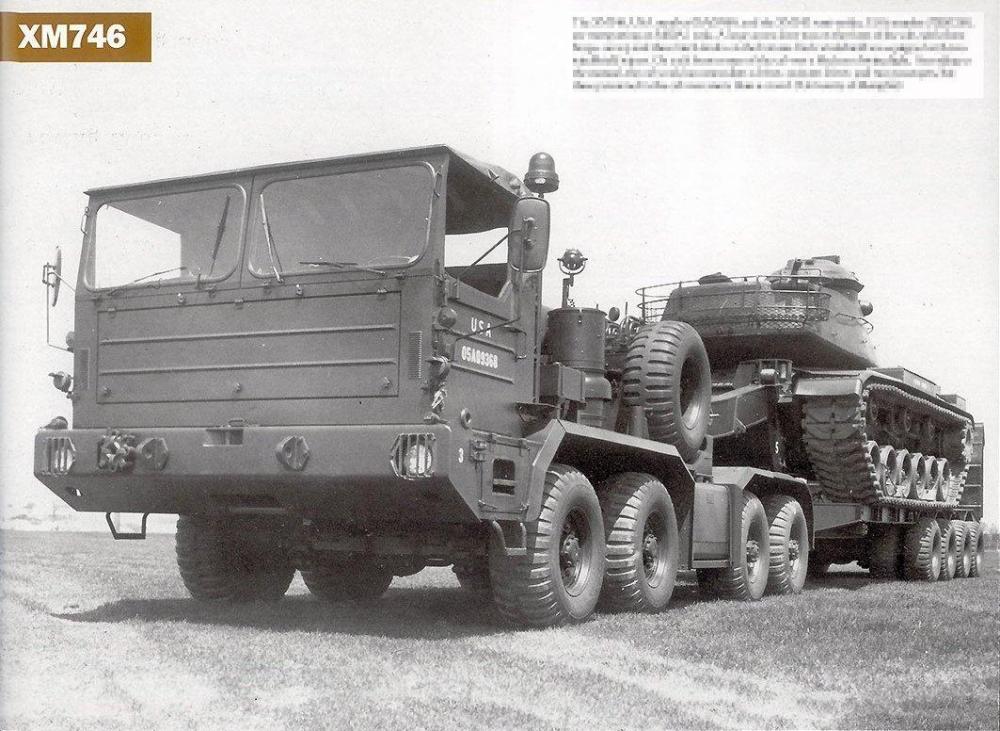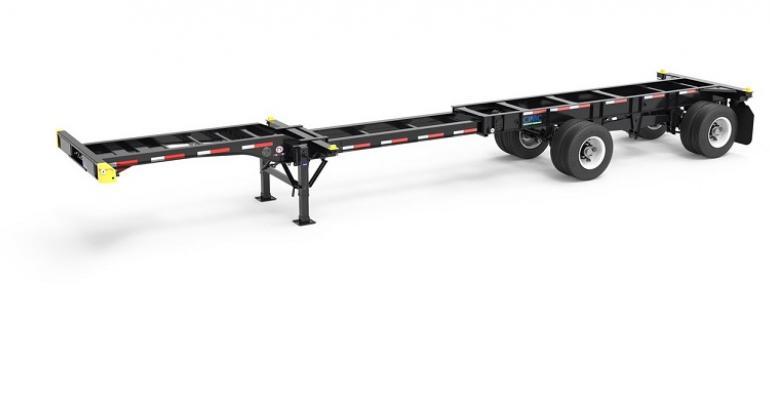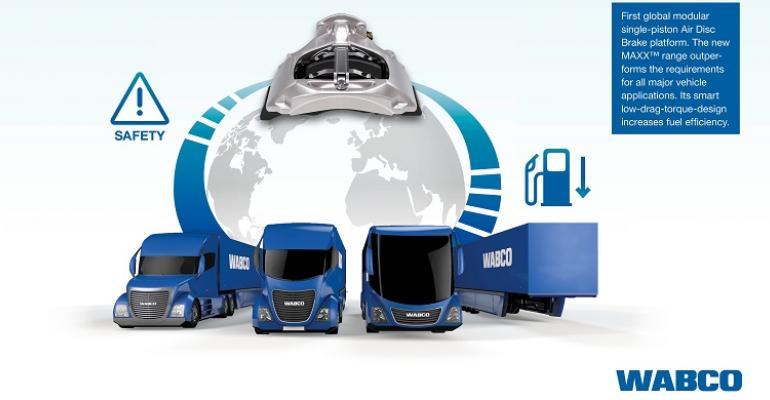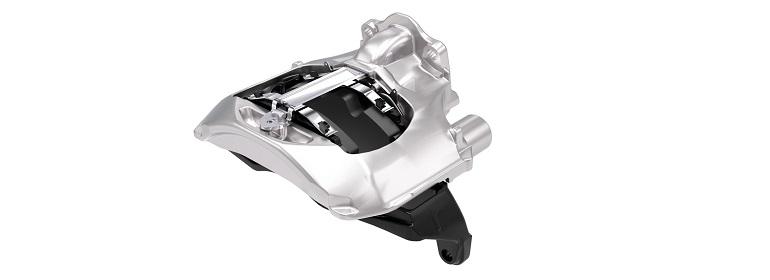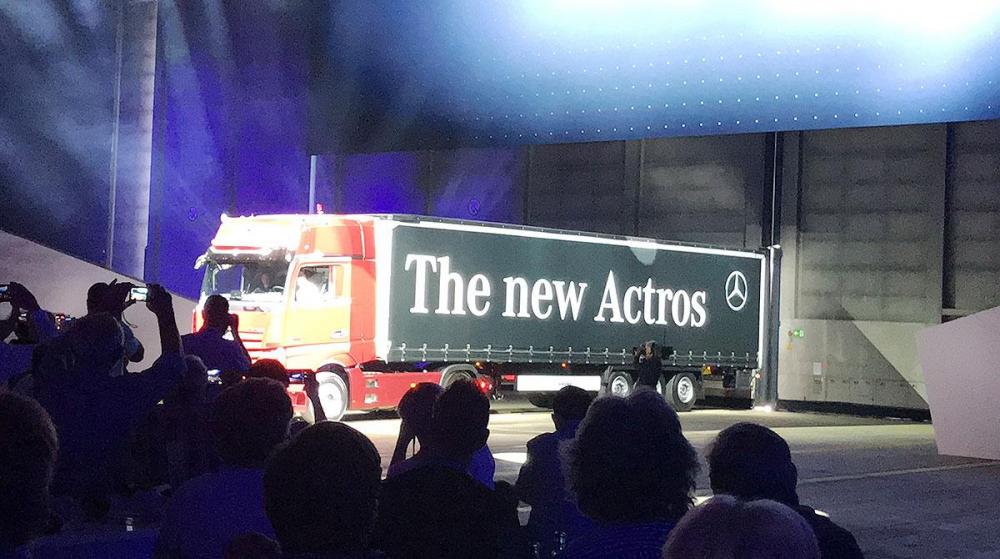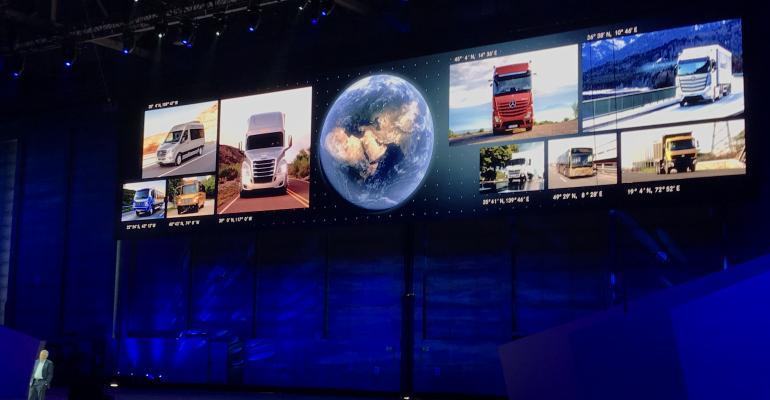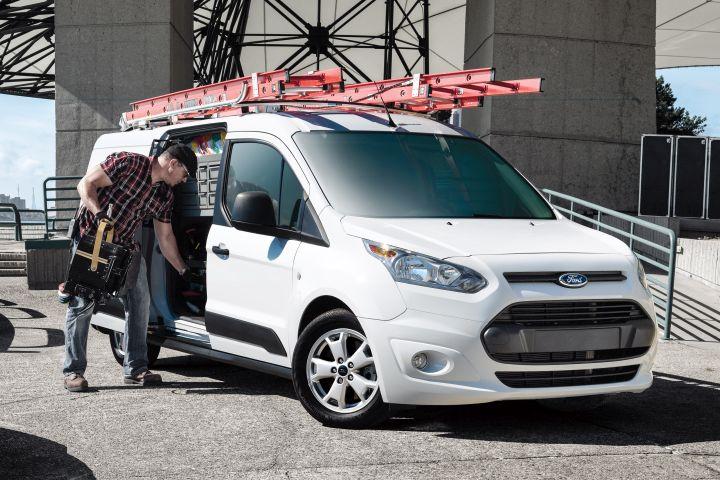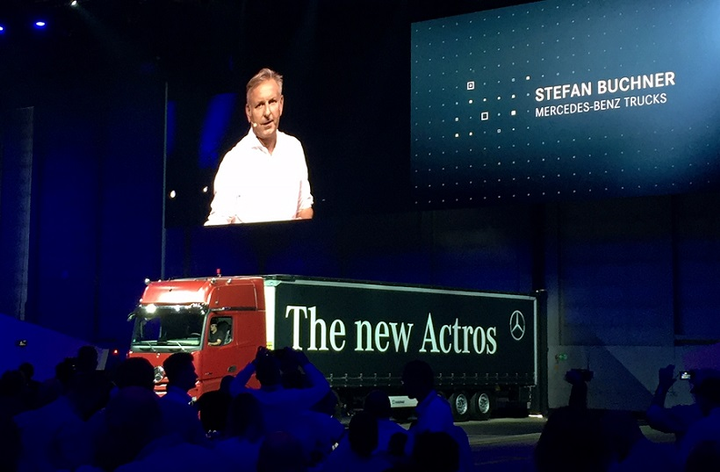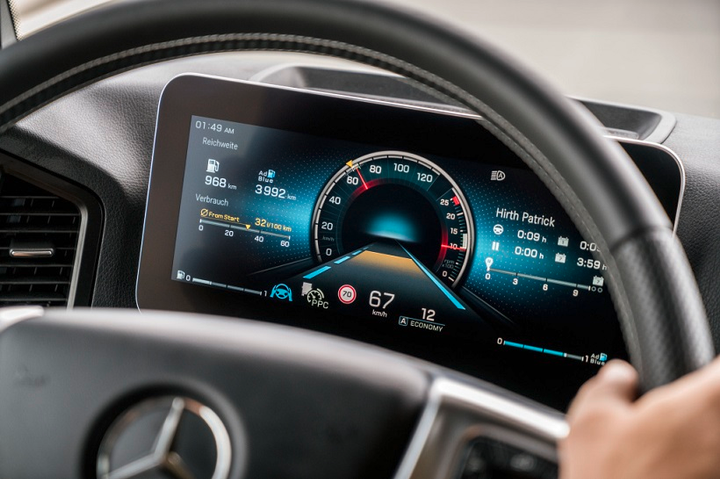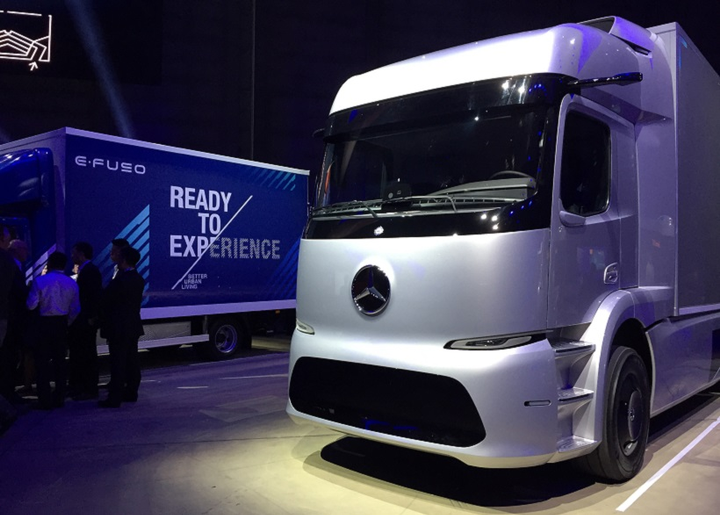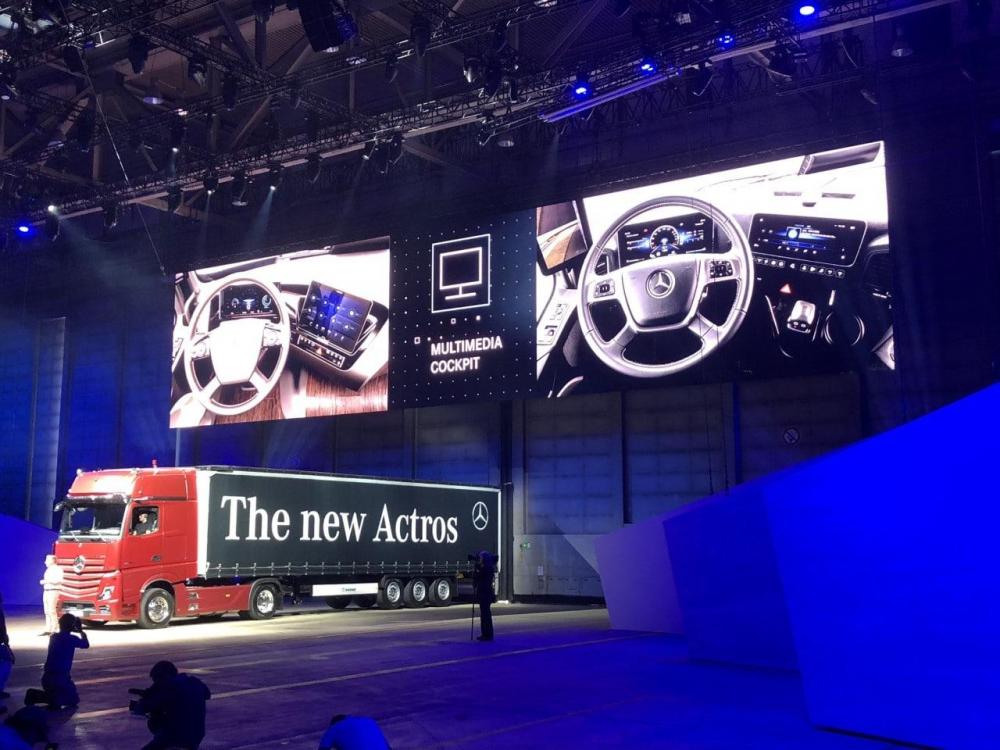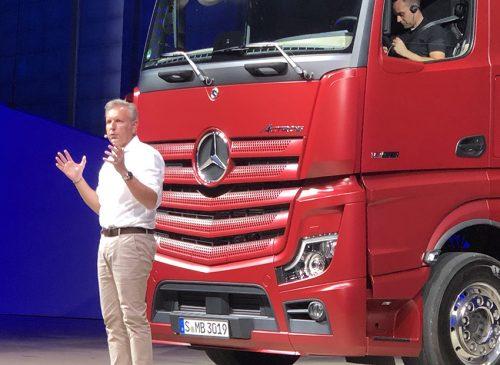
kscarbel2
Moderator-
Posts
18,818 -
Joined
-
Days Won
114
Content Type
Profiles
Forums
Gallery
Events
Blogs
BMT Wiki
Collections
Store
Everything posted by kscarbel2
-
Cummins PowerDrive Powertrain Turned a T370 Into a Hybrid
kscarbel2 replied to kscarbel2's topic in Trucking News
Cummins Debuts its Unique and Versatile Hybrid PowerDrive at IAA Commercial Vehicles Show Commins Press Release / September 19, 2018 The advanced suite of plug-in hybrid electric powertrain solutions further expands Cummins’ broad portfolio Cummins Inc. unveiled the PowerDrive, an advanced suite of plug-in hybrid electric powertrain solutions spanning light, medium and heavy-duty applications, at the 2018 IAA Commercial Vehicle Show. This further expands Cummins’ broad portfolio of low emissions and fuel-efficient power solutions that includes clean diesel, near-zero natural gas, and fully electric to help each customer’s distinct needs. This unique hybrid system is centre stage at the Cummins booth in an electric hybrid utility truck, a Kenworth T370. As the most versatile hybrid system on the market today, the Cummins PowerDrive offers both parallel and series capabilities. The PowerDrive replaces the conventional transmission and switches in real time between two hybrid and two pure electric modes, optimizing the powertrain for the best fuel economics in any driving situation. The vehicle is also configured with exportable grid quality electric power to recharge vehicles and a recovery crane operating on either electric or engine power take-off. The Cummins PowerDrive system has travelled more than six million miles in a fleet setting in the United States and China, and work is underway to introduce it to the European market in the near future. Its flexible architecture means the PowerDrive system can be combined with various sizes of diesel or natural gas engines and battery pack outputs. “With a 100-year-long track record of powering our customers’ success, Cummins demonstrates once again that we are transforming the future of transportation by offering our customers the broadest and most cutting-edge power portfolio backed by our expansive service capabilities," said Julie Furber, Cummins Executive Director of Electrified Power. “The Cummins PowerDrive is intelligent, versatile and compact, providing our on-highway customers the flexibility needed to meet the demands of their diverse jobs and markets. Cummins is ready to offer the new PowerDrive suite through our OEM partners. We look forward to discussing how the PowerDrive’s compact packaging envelope and weight saving benefits will enable OEMs to produce PHEV (plug-in hybrid electric vehicles) vehicles for diverse needs without compromising performance or range.” Cummins PowerDrive The flexible hybrid architecture seamlessly shifts between pure electric for environmentally sensitive areas with a 50-mile (80 km) range and hybrid for jobs requiring more than 300 miles (480 km). It operates as a hybrid in either series or parallel configuration modes. Series is better suited to low road speeds such as urban driving (stop/start conditions), while parallel is ideal for higher road speeds on the highway. In a series hybrid, the electric motor is the only means of providing power to the wheels. The motor receives electric power from either the battery pack or from the engine-generator. In a parallel hybrid, the engine and electric motor combine to provide the power that drives the wheels. The third mode of electric plus comes online when higher energy is required when the system senses gradient climbing or acceleration for overtaking. The future of transportation demands low emissions without comprising fuel economy or drivability, and the PowerDrive is designed to meet these needs. A US Class 6 truck powered by the PowerDrive with a 50-mile (80 km) electric range, realizes reduced emissions by up to 80 percent compared to conventional vehicles. Similarly, fuel costs are reduced by between 40 to 80 percent depending on the drive cycle. Electric Hybrid Utility Truck Profile The Cummins PowerDrive 6000 is paired with a Cummins B6.7 in the Kenworth T370, a US Class 6 truck. The vehicle’s gross weight is 33,000 lbs (15 mt gvw). The service vehicle was commissioned by Cummins to support EV and PHEV vehicle field tests and pilot routes. It showcases three vehicle charging stations (1: 100 kW fast charge and 2: 6.6 kW standard chargers) with direct charging cables from the truck to the PHEV or EV vehicle requiring charging. . -
Cummins Press Release / September 15, 2018 The Cummins Repower Cruise is a convoy of enthusiasts driving across some of the most scenic drives in the western half of the United States to celebrate the Cummins Repower program and the R2.8 Turbo Diesel crate engine. The Cummins Repower Cruise 2018, taking place Sept. 14 - 20, 2018, will be hosted by special guest Ian Johnson from “Big Tire Garage." . . . . .
-
Cummins PowerDrive Powertrain Turned a T370 Into a Hybrid
kscarbel2 replied to kscarbel2's topic in Trucking News
-
Cummins Press Release / September 19, 2018 The need to 'Power What's Next' is the driving force behind the advanced power systems and component technologies presented by Cummins at the 2018 IAA Commercial Vehicles show in Hanover, Germany. Displaying our vision of the future of power with a product portfolio that is rapidly evolving from clean diesel and natural gas to hybrid power systems, integrated powertrains, and zero-emissions electric - offering a unique energy diversity for transport solutions. .
-
Sonia Straface, Truck News / September 19, 2018 HANNOVER, Germany – Goodyear launched its first-ever full silica tread compound tire at the IAA truck show in Germany. The new tire, called Fuelmax Performance, is what Goodyear says is its most fuel-efficient tire to date. The tire has hit the European grade A for fuel efficiency and met full Three Peak Mountain Snow Flake winter tire requirements. According to David Anckaeart, v.p. of Goodyear Commercial Tires Europe, the new tires will help long-haul European fleets save money on fuel, while meeting the EU’s ambitious CO2 targets (heavy duty vehicles are to reduce their CO2 emissions by 15% in 2020, and 30% by 2030.) Goodyear estimated that fleets in Europe using the tires would save up to 290,000 Euros in fuel costs and 557 tonnes of CO2 emissions per year. “Tires are crucial for sustainable mobility and are core components of vehicle performance,” Anckaert said. “The new Goodyear Fuelmax Performance tires demonstrate our understanding of the challenges and opportunities that environmental objectives pose for our customers. They further show our commitment to supporting OEMs and fleets in achieving those objectives and reducing costs.” .
-
Bloomberg / September 19, 2018 Volkswagen AG’s truck unit is pushing to reduce its dependence on its main European market and lift profit margins in a challenge to commercial-vehicle industry leaders Daimler AG and Volvo AB. Future moves could include both acquisitions and entering more alliances, the unit’s head Andreas Renschler told reporters on Tuesday at the biannual international truck show in Hanover, Germany. VW’s commercial-vehicles division, named Traton AG, so far lacks the geographic reach of its two larger peers, with its U.S. presence limited to a stake in Navistar International Corp. “We’re keeping all options open as part of our strategy,” Renschler said, adding his division had room to improve its profitability to achieve an average return on sales of 9 percent across industry cycles. “Traton is already the market leader in Europe and Latin America and we want to expand that position.” Under Renschler’s leadership ,VW reorganized the division and will soon mandate banks and hire legal advisers ahead of a possible initial public offering. Renschler decoupled decision-making from VW’s larger cars division and has deepened cooperation between the Swedish Scania and the German MAN brands to lower costs. Similar efforts had often been undermined by internal rivalries in the past. Volkswagen rose 2.6 percent to close at 148.24 euros in Frankfurt trading, giving a market value of 74 billion euros ($86 billion). Never Say Never VW acquired a 16.8 percent stake in U.S. peer Navistar two years ago, laying the groundwork for a footprint in the North American market, the truck industry’s largest source of profits. Daimler’s Freightliner and Volvo’s Mack nameplates generate significant sales in that region. While a takeover of Navistar “isn’t currently on the agenda,” it’s a case of “never say never,” Renschler said. In a subsequent Bloomberg TV interview, he said he’s “very happy” with the progress on cooperating with Navistar. Traton is pursuing a strategy to lift its profitability, trailing a target of 9 percent average profit margin after returning 6.9 percent on sales last year for an operating profit of 1.7 billion euros. VW’s trucks unit and its alliance partners combined produce about 422,000 heavy-duty vehicles, offering more opportunity to generate economies of scale than any peer, Traton Chief Financial Officer Christian Schulz said. That’s possible even without owning an equity stake in the partner company, he said. The main focus is on engines and powertrains, which account for some 60 percent of vehicle costs. Traton has forged an alliance with Japan’s Hino Motors Ltd. this year and earlier Tuesday announced it will establish a joint-venture with its Chinese partner Sinotruk Hong Kong Ltd. MAN bought a 25 percent stake in Sinotruk some years ago, but so far had little influence in any business decisions. Cooperation efforts in China, the world’s largest commercial vehicle market, don’t have to be restricted to Sinotruk, Renschler said. To read more about Volkswagen’s for a truck share sale plan, click here The trucks business has a value of about 28.5 billion euros, according to Bloomberg Intelligence, comprising the Scania and MAN truck and bus marques as well as a business in Brazil. German rival Daimler, the maker of Mercedes-Benz luxury cars and also the world’s largest truckmaker by revenue, is adopting a new corporate structure as well that will grant its truck business more independence. But executives have remained tight-lipped so far about a possible IPO of a minority stake. Daimler officials have denied any plans for a complete spinoff. Renschler said both Scania and MAN have potential to improve profit margins. Scania already generates some of the truck industry’s highest returns of 10 percent. MAN has undergone several cost-cutting rounds in recent years and earnings have started to improve, but still remain well below Traton’s 9 percent target. Traton is hosting an investor day in Hanover on Thursday. .
-
Jeff Crissey, Commercial Carrier Journal (CCJ) / September 19, 2018 During a press gathering at IAA 2018 in Hannover, Germany, Navistar executives updated the company’s position within Traton Group, Volkswagen Truck & Bus’s alliance group formed earlier this summer that includes subsidiary companies and joint venture partnerships. Two years ago, VW purchased more than 16 percent of Navistar’s shares and gained two board seats. In addition, the two companies entered what would become the first joint venture for the Traton Group aimed at creating cooperative alliances, leveraging scale for raw materials and components, global expansion and elevating brand performance for companies across the group. VW since has increased its investment in Navistar stock to 17 percent. “The purpose of the procurement joint venture is to provide us and them access to scale,” said Troy Clarke, Navistar president, chairman and CEO. “When you put our volumes together, it becomes a very sizable procurement enterprise.” The JV also allows Navistar and alliance partners to license technology and the opportunity to participate in new technology development. “We are on path with the synergies that we publicized back when we announced the [procurement joint venture],” said Walter Borst, Navistar chief financial officer. “We said we would have $500 million in cumulative synergies in five years… I’m happy to say that a year and half year in we are on track. In 2018, it already is making a positive impact to our bottom line.” Just before IAA 2018, Traton Group announced its second OEM relationship when it signed a joint venture with Hino Trucks and now have a stake in Chinese truck manufacturer Sinotruk. “The opportunities are more significant than what we originally thought,” said Borst in terms of technology sharing and future product development that includes powertrain integration with Traton family members by 2021. “Starting in 2020 and going forward, you will see more integration of our product with offerings you see [from other alliance partners],” said Friedrich Baumann, senior vice president of strategy and planning. .
-
Heavy Duty Trucking (HDT) / September 19, 2018 Eaton has developed several components designed to improve efficiency of electric, hybrid and conventional vehicles and showcased the new technologies at the IAA Commercial Vehicles Show in Hannover, Germany. 4-Speed Transmission for Electric Vehicles The company has developed a 4-speed transmission for electric vehicles designed to meet growing demand in delivery and bus segments. The 4-speed transmission was designed to address an issue related to single-speed (direct-drive) drives – contradictory requirements for high efficiency at top speeds and increased torque at launch and low speeds. The automated manual transmission has a torque capacity up to 885 lbs.-ft. and electric gearshaft actuation that enables original equipment manufacturers to use smaller, more efficient motors. The fine-pitch helical gears offer smooth, low-noise operation, and the AMT shifting strategy is designed for maximum efficiency, which extends range and battery life. The system is designed to improve performance in areas of range, grade performance, acceleration, and efficiency in the medium-duty and bus electric vehicle commercial markets. It is also a plus for applications that require low-noise operations and low emissions, including refuse, utility trucks, dump trucks, and emergency vehicles, according to Eaton. “Eaton has been in the hybrid transmission business for 15 years, and we have more than two billion miles of reliable, efficient operation of hybrid transmission-equipped trucks and buses on the road,” said Scott Adams, senior vice president, eMobility, Eaton. “Our 4-speed transmission provides uncompromised launch ability on grades and always keeps the electric motor operating in its most efficient region.” Mild Hybrid Electrically Regenerative Accessory Drive Eaton also revealed that it is developing a 48-volt, mile hybrid electrically regenerative accessory drive. It features a 48-volt motor that can charge a vehicle’s batteries and run the air conditioner and replace the alternator in linehaul commercial vehicles. “The 48-volt mild hybrid redefines traditional belt-mounted accessories to save fuel and reduce emissions in several ways. Enabling start/stop and engine-off coasting saves fuel while driving,” said Jeffrey Lowinger, president, eMobility, Eaton. “A regenerative system captures energy while driving and is used to keep the sleeper cab comfortable overnight without idling the engine. We think it is an efficient and cost-effective solution for our linehaul customers.” The 48-volt mild hybrid drive improves fuel efficiency by mounting the accessories on the transmission, delivering up to 2% annual fuel savings compared with a baseline truck equipped with an Eaton Cummins Automated Transmission Technologies Endurant 12-speed automated manual transmission by eliminating the alternator and implementing engine-off coasting. Exhaust Gas Recirculation (EGR) Pump To help save fuel and meet stringent emissions standards, Eaton is also developing an exhaust gas recirculation pump for heavy-duty diesel engines. Eaton’s positive-displacement TVS EGR pump enables the use of a high efficiency turbo to lower engine pumping losses and increase fuel economy. The TVS EGR pump is driven by a 48-volt electric motor, making it completely independent from engine speed and more controllable than comparable pump-less EGR systems. The TVS EGR pump currently is in the prototype stage and is undergoing evaluation with heavy-duty commercial vehicle engine manufacturers that have requested the technology. A preliminary production start date has been set but not announced publicly. “We are leveraging the precision air control of our twin-vortices (TVS) pump technology to allow a high volume of exhaust gas recirculation to dilute air mixture with low pumping loss, while also lowering in-cylinder temperatures,” stated an Eaton release. “This allows an improvement in fuel economy, while at the same time lowering harmful NOx emissions.” .
-
Heavy Duty Trucking (HDT) / September 19, 2018 Cummins showed off an emissions reduction concept that promises drastic reductions to NOx and particulate matter emissions in future diesel engines. The Cummins emissions control system technology was on display at the IAA Commercial Vehicles Show in Hannover, Germany and Cummins said that it could minimize emissions enough to meet Euro 7 emissions regulations in the European market. The concept combines turbocharged air management with exhaust aftertreatment as a single close-coupled system with a new rotary turbine control. The design makes use of Cummins latest air and thermal management advances and the company says it could covert almost all NOx emissions to clean gas as it interacts with the selective catalytic reduction unit. “This innovative system allows further reduction in NOx and PM emissions, while simultaneously improving fuel efficiency,” said Tim Proctor, Cummins executive director of product management & market innovation. Other innovative technologies under development by Cummins to reduce friction and parasitic losses will also continue to make the diesel engine even more productive and energy efficient. Additionally, the use of enhanced design tools and advanced materials such as composites will bring opportunities to reduce component weight while retaining strength, further enhancing vehicle productivity.” The system also includes Cummins connected suite of wireless monitoring, reporting, calibrating and servicing applications to help boost vehicle uptime. It also features over-the-air trim and parameter calibration to allow fleet managers to customize power and speed settings to match business needs and driver behaviors, road conditions, and geographic coordinates. The technology suite also uses powertrain automation to improve driver efficiency by up to 6%, according to the company. Features such as Predictive Cruise Control use vehicle GPS to see the road ahead and precisely adjust speed to upcoming terrain. SmartCoast places the driveline into neutral on downhill gradients using vehicle momentum to save fuel, while SmartTorque2 constantly calculates the exact torque needed for the truck payload to minimize downshifting. “While Cummins has a vigorous electrification program underway, our other key message at IAA is that the diesel engine is not standing still,” said Proctor. “With our technical advancements, we see diesel remaining as the primary source of power in the commercial vehicle sector for the foreseeable future. Cummins is committed to ensuring the power of choice is available for our customer’s many different vehicle types, duty cycles and business requirements.” .
-
Heavy Duty Trucking (HDT) / September 19, 2018 Cummins unveiled its PowerDrive suite of plug-in hybrid electric solutions on a functional Kenworth T370 utility truck at the IAA Commercial Vehicles Show in Hannover, Germany. PowerDrive replaces the conventional transmission and switches in real time between two hybrid and pure electric modes, optimizing the powertrain for the best fuel economy in any situation. The hybrid utility truck featured a recovery crane that could operate off of either engine power take-off or electric power. The vehicle is also configured with exportable grid quality electric power to recharge other vehicles. The PowerDrive hybrid system is designed for light, medium, and heavy-duty applications and it can be paired with various sizes of diesel or natural gas engines and battery pack outputs. So far, vehicles using the system have travelled over 6 million miles in a fleet setting in the U.S. and China. Work is underway to introduce it to the European market in the near future. The flexible hybrid architecture shifts between pure electric with a 50-mile range and hybrid for jobs requiring more than 300 miles of range. It operates as a hybrid in either series or parallel configuration modes. Series is better suited to low speeds and urban driving while parallel is ideal for higher road speeds on the highway. In a series hybrid, the electric motor is the only means of providing power to the wheels. The motor receives electric power from either the battery pack or from the engine generator. In a parallel hybrid, the engine and electric motor combine to provide the power that drives the wheels. The third mode of electric plus comes online when higher energy is required when the system senses gradient climbing or acceleration for overtaking. The Kenworth T370 with PowerDrive 6000 is paired with a Cummins B6.7 engine. The service vehicle was commissioned by Cummins to support EV and PHEV vehicle field tests and pilot routes. It features three vehicle charging stations with direct charging cables from the truck to the PHEV or EV vehicle requiring charging. A Class 6 truck powered by PowerDrive can realize reduced emissions of up to 80%, according to Cummins, and can also reduce fuel costs. “The Cummins PowerDrive is intelligent, versatile and compact, providing our on-highway customers the flexibility needed to meet the demands of their diverse jobs and markets,” said Julie Furber, Cummins executive director of electrified power. “Cummins is ready to offer the new PowerDrive suite through our OEM partners. We look forward to discussing how the PowerDrive’s compact packaging envelope and weight saving benefits will enable OEMs to produce PHEV (plug-in hybrid electric vehicles) vehicles for diverse needs without compromising performance or range.” .
-
Deborah Lockridge, Heavy Duty Trucking (HDT) / September 19, 2018 When looking at the development of new products, Daimler Truck and Bus head Martin Daum says, there are headlines, knowledge, and business. And while business means products that customer can order currently to help them succeed, at the same time there’s the broader economic side of business to consider – and Daum’s not as euphoric about the current hot market as some of his competitive counterparts. Daum shared his thoughts on these topics in a roundtable discussion at the IAA Commercial Vehicles show in Hanover, Germany, Sept. 19. From Headlines to Real World Flashy demonstration vehicles like the fully autonomous van concept that rolled onto the show floor earlier that morning generate headlines, he explained. From there, the company develops knowledge that eventually allows some version of those technologies to appear in real-world vehicles that fleets can order – and that’s the business. Take the new Mercedes Actros heavy-duty truck, which boasts features such as Active Drive Assist, flat screen panels for a dashboard, and MirrorCam, which replaces the traditional truck mirrors with a camera system for improved visibility and aerodynamics. When asked whether these features will make their way to North America, Daum said that he was heeding corporate advice to not be the CBS, or “chief bean spiller,” but he told reporters that “you can be sure that everything you’re seen today you’ll see on the streets of the U.S., but I’m not telling you when.” For instance, the MirrorCam would not be legal in the U.S., where regulations require mirrors. “With conventional trucks in the United States, we have different angles especially when it comes to the front visibility, but we are in talks with legislators to get innovations into the states as well,” he said. When pressed about what we might see first, Daum said, “Whatever the customer needs most.” Another example of Daum’s headlines-knowledge-business spectrum would be electric vehicles. Daimler showed off at its IAA booth electric and hybrid vehicles from vans up to heavy trucks and buses – some available today in various markets, such as the eCanter and the new eVito van; some concepts or vehicles in various stages of testing, such as the eActros, an electric Class 8 Fuso, or a fuel cell hybrid Sprinter F-Cell. There’s talk of hydrogen fuel cells as a way to extend the range of electric trucks, and in fact Daum said Daimler is designing electric drivetrains to have the flexibility to replace batteries with fuel cells and hydrogen tanks. “I would say we have a long history in [fuel cell research]. We don’t see the technology at the moment ripe for market. It works technology wise, but it’s twice as expensive than today’s electric trucks – which are twice as expense as internal combustion trucks. And we don’t have the hydrogen infrastructure. If there’s a market, we’ll be there.” Meanwhile, in traditional drivetrains, as the company works to develop trucks to meet the upcoming GHG2 fuel efficiency standards, Daum said, “We still have a lot of things in store. You’ll see a lot of presentations in the next two or three years with significant details on amazing technology with the traditional product. I know already the next phase, and it will be amazing…. We want to lead that market and set the pace.” What Goes Up Must Come Down With true German understatement, Daum said, the outlook for 2019 “seems at the moment to be not bad. The sentiments of our customers is strong, the demand for freight is high, freight rates continue to be high, the new trucks are better than trucks still on the road so you see this replacement cycle.” However, he said, his internal compass from his years heading up Daimler Trucks North America tells him, “I think the markets are, a little bit too high. In years when the market is too high above the long-term average, it foreshadows a valley. The higher it is before, the deeper the valley will be. So I am not rejoicing.” DTNA is sold out for 2018 and basically for the first half of 2019, Daum said. When asked what his biggest fear for 2019 is, he said, “What can change a strong market? I would say the economy — start a trade war, get into recession in the States. High interest rates... there’s a lot of things on the horizon. But I tell you this is daily life for the executive of a truck company and we’ll deal with it.” When asked about the Trump administration’s tariffs, Daum declined to comment on specifics, but said, “In general, I am a huge proponent of open markets. We are one globe, we are one people on that globe.” By working globally, he said, companies and countries alike create a “bigger cake,” a stronger economy to share in. “It doesn’t matter so much what my share is because I have more than I did yesterday. Whoever separates himself from the global market, ultimately that country suffers the most. You get a bigger share, but the cake shrinks. As a global company it’s especially threatening. We are strongly embedded in the local economies we serve. If this global exchange of ideas, people, and goods gets interrupted, then everyone will suffer,” he said, from companies to consumers to the broader economies. “A trade war at the end of the day will have no winner, just losers.” .
-
Rare Military Macks
kscarbel2 replied to rsb502's topic in Antique and Classic Mack Trucks General Discussion
In this picture? M746 (aka. XM746, HET-70) Designed by Chrysler in cooperation with West Germany's Faun Werke, but Ward La France was low bidder. . . -
Trailer-Body Builders / September 18, 2018 CIMC Intermodal Equipment, a manufacturer of intermodal chassis trailers, recently unveiled its new REVERE chassis. The REVERE 20-foot/40-foot City Combo Tandem WS chassis design is based on CIMC’s 2019 Premium Specification, which includes component specifications from industry-leading manufacturers: Electric harness and lights from Phillips Industries KIC/Accuride 10-year wheel ends TSE brake chambers and slack adjusters Holland Saturn 62 IM landing gear Hutchens spread axle mechanical suspension Bendix ECU and air valves The REVERE is a premium chassis, CIMC said, with all post-frame assembly done in the US with USA-made products and components. It includes CIMC standard KTL powder coating and is assembled using robotic precision welds and laser metal cutting processes. CIMC processes and standards, along with superior component specifications, support a 10-Year warranty on all non-wear items. “We’re bringing a special chassis to the North American market,” said Frank Sonzala, CIMC president and CEO. “With the highest-quality components supplied by our partners and spec’d as standard equipment on the REVERE, this chassis undoubtedly commands a 10-Year warranty. CIMC continues to benchmark our industry with standards that meet or exceed customer demands. “The REVERE is the just the latest in our efforts to transform the intermodal segment.” The REVERE will carry one 20-foot or one 40-foot ISO container. It meets all TOFC, AAR, DOT, FMVSS, ISO, ANSI, SAE and TTMA specifications .
-
Trailer-Body Builders / September 18, 2018 WABCO has introduced a whole new generation of high-performance MAXX single-piston air disc brakes for trucks, buses and trailers. The new line accelerates the industry’s conversion from conventional drum brakes to air disc brakes (ADBs). The fifth-generation range of single-piston ADB technology is suitable for all types of light-, medium- and heavy-duty vehicles, WABCO said. MAXX’s new lighter-weight, high-performance and low drag-torque design boosts fuel efficiency and enables increased transport payloads. “Powerfully demonstrating WABCO‘s global single-piston ADB leadership, this cutting-edge MAXX ADB range offers clear technology advantages and differentiating value over both drum brakes and dual-piston ADB technology, which is reflected in the significant volume of advance orders being received from original equipment manufacturers world-wide,” said Jorge Solis, president of WABCO’s truck, bus and car OEM division. “WABCO’s mastery of single-piston ADB technology has been refined over more than two decades and is fully trusted by our customers across the globe. Its world-class quality has been clearly demonstrated in more than six million wheel-ends, including for the most demanding heavy-duty truck applications. Exceeding the performance standards of other ADB systems on the market, WABCO’s pioneering single-piston MAXX technology is the definitive industry benchmark that others are now seeking to emulate.” With 20% fewer parts than the current design, and more than 40% fewer parts compared to other ADB brands, the new MAXX platform offers superior reliability and an excellent weight-performance ratio, the company said. Delivering enhanced fuel efficiency, the compact design offers an average weight of 35 kilograms per ADB in a six-by-two wheel truck application – 12 kilograms less per truck than other manufacturers’ European heavy-duty ADB systems. Further demonstrating the advantages of WABCO’s single-piston ADB technology over other ADB systems available on the market, MAXX intelligently manages taper wear compensation with a superior patented design suitable for all truck and trailer applications, including the most demanding heavy-duty truck requirements, helping extend brake pad life. Available in 2019, WABCO’s new MAXX modular platform is simultaneously available in 17.5-inch to 22.5-inch rim sizes. The portfolio spans from the MAXX 17 and MAXX 19 light- and medium-duty brakes to MAXX 22 heavy-duty brakes, including MAXX 22L, the industry’s lightest rear-axle brake of its kind, according to WABCO. It also includes the MAXXUSTM heavy-duty truck ADB, specifically tailored for the North American market. “With many of the world’s leading global OEMs increasingly converting to WABCO’s MAXX ADB technology, including for 30,000 Nm heavy-duty applications, we see generally that the significant safety and cost benefits offered by WABCO’s single-piston platform are helping to accelerate the industry’s migration from dual-piston ADB and conventional drum brakes,” Solis said. .
-
All the major North American truck journalists are covering the New Actros launch. Rare that they report on a global market truck. Interesting.
-
New Mercedes-Benz Actros Showcases Daimler’s Next-Gen Safety Technologies Joe Howard, Transport Topics / September 18, 2018 HANOVER, Germany — Touting technology that is as “easy to use as a smartphone,” Daimler AG on Sept. 18 showcased safety systems on the next generation of its global highway tractor that it said points the way forward for connectivity in the commercial sector. Hosting 500 members of the international press from 45 countries in a hangar at the Hanover airport, Daimler in a media event prior to IAA 2018 showcased its new Mercedes-Benz Actros highway tractor, a key component of its global lineup and a vehicle that features a suite of technologies that the company says will make the truck a safer tool for its customers. That includes a suite of safety systems designed to limit the potential for accidents, including Active Drive Assist, which will intervene if, for example, a truck accidentally leaves its lane due to wind. In this case, the system will steer the truck back into its lane. This system also will apply brakes if it detects an object in the vehicle’s way or if the truck gets too close to another vehicle. “That is a huge step forward in terms of safety,” said Stefan Buchner, head of Mercedes-Benz Trucks, during a presentation here. “Dealing with this truck is as easy as using a smartphone.” Also included is Active Brake Assist 5, an enhancement of Active Brake Assist 4 that improves how the radar and camera systems interact and which can react to people that cross the vehicle’s path at speeds of up to 50 kph (31 mph). The system can apply full braking in these cases. If the system detects either a pedestrian or a stationary object, the system alerts the driver through a multistage warning system. If the driver does not intervene, the system will apply emergency braking, within specified limits. Daimler also is introducing its “MirrorCam” technology on the truck, which uses cameras to replace mirrors. The system, Buchner said, gives the driver “much-better all-around visibility from the interior — the driver can see exactly what the cameras are seeing,” via screens inside the cab. This includes multiple camera functions, including one that resembles the view of a conventional mirror, along with a view shown when taking corners that includes the tractor and trailer, Daimler said. Distance lines also are incorporated to help the driver assess traffic coming up from behind. There also is an additional line that can be individually set to show the end of the trailer. When the vehicle is reversing, the system gives the driver a split view; the upper section of the display shows the area closer to the truck, while the lower part displays the area away from the vehicle. “We are not only thinking about the future — we are creating it,” Buchner said. The company’s near-term future in terms of sales is bright, said Martin Daum, global head of Daimler Trucks and Buses. In introductory remarks, he said orders are up 30% for the first half of the year and that Daimler “remains optimistic” for the rest of 2018. He said the company is “basically sold out for the year” and predicted that 2018 will be a record year for the manufacturer. “We are very busy these days,” he said. .
-
Ahead of IAA, Daimler shows the future is drawing closer Neil Abt, Fleet Owner / September 18, 2018 HANOVER, Germany. In the summer of 2014, Daimler Trucks unveiled Future Truck 2025, which in many ways ushered in a new era of trucking. After demonstrating a self-driving truck on a closed stretch of the Autobahn that July, the company used the IAA Commercial Vehicles show in the fall to display a sleek, modern design for that Mercedes-Benz concept truck. I attended both events that year and was among those left feeling that while Daimler had successfully created an attention-grabbing vehicle, there remained many questions about how "real" any of what we were seeing really was. Fast forward to 2018, and it seems Daimler is on its way to proving skeptics like myself wrong. "The future is here," declared Stefan Buchner, head of Mercedes-Benz Trucks, during a media event on Sept. 18, one day ahead of the start of the 2018 IAA show. Buchner made the comment as he emerged from the new Mercedes-Benz Actros, which he said incorporates numerous features from the conceptual Future Truck. The Actros, which is basically the European equivalent of the Freightliner Cascadia, included several “world premieres.” That is important for North American trucking fleets because anything debuting at IAA is likely coming to North America in the near future. The new Actros includes active drive assist, which "gives the driver access to semi-automated driving at all speeds for the first time in a series production truck," Daimler said. It can apply full emergency braking up to a speed of about 32 mph. This supports all drivers, "especially on monotonous, long-distance roads and [in] annoying traffic jams," Buchner said. Additionally, sideguard assist technology provides visible warnings if a pedestrian or cyclist is in a blind spot. Another new feature is MirrorCam, based on concepts first seen on the Future Truck. The system, which replaces traditional side mirrors, offers a wider range of vision and background illumination to adjust for poor lighting. Inside the cab, there is also a multimedia cockpit display aimed at simplifying the business and infotainment options a truck driver often accesses while in motion. That, too, is based on systems first shown in the Future Truck. While the new Actros is a more traditional cabover design for the European market, the electric eActros also on display is similar to that sleek Future Truck shown back in 2014. It was another example of how those four-year old concepts are becoming a reality. Daimler’s pre-IAA event, attended by 500 journalists from 45 countries, included various electrification and connectivity advancements for its truck, van, and bus products. I will be covering these developments next week, as well as other highlights from the hundreds of other companies exhibiting at IAA. If today’s event was any indication, it is certain to be a fascinating few days. .
-
Heavy Duty Trucking (HDT) / September 18, 2018 Commercial vehicles are expected to run on diesel fuel through 2040 due to increases in fuel economy, according to new research from IHS Markit. In 22 years, 66% of new medium and heavy commercial vehicles sold in the U.S. will be fueled by diesel, compared to 80% today. Range and load capacity requirements from long-haul, on-highway trucking will keep diesel relevant in the short- and long-term, while other vehicle types will grow in popularity as technology continues to advance, according to the forecast. The findings came in Reinventing the Truck, a new multi-client research initiative that analyzes the world’s largest trucking markets. “Understanding the future course of commercial trucking is so important because its impacts will reverberate far beyond just the trucking industry and through a whole host of industries,” said Daniel Evans, vice president of the IHS Markit downstream practice and co-author of the study. “Trucking accounts for half of diesel demand globally, or one-sixth of oil demand, making the future of trucking critically important for the oil industry. A wholistic, system-wide view is needed to see the full picture of this new reality of transportation.” The report predicts a 15% compound annual growth rate for battery electric vehicles in the U.S. through 2040, as acquisition rates increase for medium-duty trucks. The initial cost disadvantage of BEVs will require adoption from larger truck fleets first, before they can be implemented smaller fleet owners and operators.
-
Ford Offers Fleet-Only Options for 2019 Transit Connect Paul Clinton, Heavy Duty Trucking (HDT) / September 18, 2018 Fleet managers who purchase the 2019 Ford Transit Connect compact van will have a choice of several options not available to retail buyers, including an exclusive engine with a natural gas prep package and other options. The 2019 Transit Connect is entering its third generation with plenty of upgrades that include a new diesel engine choice, an array of driver-assisting technology, connectivity, and fuel-saving technology. Ford has been selling the compact van in the U.S. since 2009. "Fleets have embraced the Transit Connect for its maneuverability, flexibility and efficiency," said Tim Stoehr, Ford's general fleet marketing manager. "The compact van does even more for our customers, adding two new drivetrains, including the only diesel in the segment, as well as smart, intuitive technology such as standard pre-collision assist with pedestrian detection, standard embedded modem, standard Side Wind Stabilization, available blind spot alert with cross-traffic alert, available lane keeping system, available wireless phone charging and available adaptive cruise control." Among the three available engines, Ford will offer a 2.5-liter iVCT inline four-cylinder gas engine with a CNG/propane autogas prep package as a fleet-only option on XL and XLT cargo vans and XL passenger wagons. It will be paired with a six-speed automatic (SelectShift) transmission and standard 60-amp battery that's rated at 590 CCA (cold cranking amps). An optional heavy-duty 80-amp battery is rated at 800 CCA. Other fleet-only options include a third-row seat delete in the wagon, carpeted floor cover for all rows, and two engine governors to cap top speed at 65 mph or 75 mph. Ford's MyKey programmable ignition key remains standard for Transit Connect XLT. The feature enables fleet administrators to set warnings and limits for vehicle speed, and restrict the entertainment system's audio to 45% of maximum volume. .
-
Daimler Trucks Touts Technology Advances Ahead of IAA Show Deborah Lockridge, Heavy Duty Trucking (HDT) / September 18, 2018 Daimler kicked off the bi-annual IAA Commercial Vehicles Show in Hannover, Germany, with a flashy highlight of its latest high-tech and electric trucks, vans, and buses for some 500 media representatives from 45 countries. In 2014, recalled Stefan Buchner, head of Mercedes-Benz Trucks, Daimler Trucks hosted global journalists for a special demonstration of the Future Truck 2025 concept truck, which demonstrated automated driving functions on a closed section of German autobahn. “It still gives me goosebumps” to think about it, he told reporters gathered at an airline hangar. “The Future Truck inspired the whole world. Now it’s arrived – the future is here. Four years after presenting the vision of the Future Truck, we are introducing a series production truck with many of the same advantages.” The new Mercedes-Benz Actros has more than 60 new features. According to Buchner, four of them are world “firsts,” some of which could well make their way into North American trucks in the future (just as the Future Truck 2025 demonstration in 2014 was followed up by the Freightliner Inspiration Truck driving itself across Hoover Dam for reporters the following year.) 1. Multimedia cockpit Instead of gauges and buttons, the dash features two flat screens, like elongated tablets. Both can be controlled via thumbpads on the steering wheel, and the right-hand one is also an intuitive touchscreen. 2. Active Drive Assist This feature builds on adaptive cruise control to put partially automated driving into series production. The new Active Drive Assist can brake, accelerate and steer independently. Unlike systems that only work at certain speeds, Active Drive Assist offers the driver partially automated driving in all speed ranges for the first time in a series-produced truck, according to Daimler. New elements are the active latitudinal control and the combination of longitudinal and lateral control in all speed ranges through the fusion of radar and camera information. If the truck drifts from its lane, it can automatically steer itself back. “It’s an important step to support the driver, especially on long-distance routes and in annoying traffic jams,” Buchner said. “But as we are still in partly automated mode, he still has his hands on the steering wheel.” 3. Active Brake Assist 5 Since the launch of Active Brake Assist 1 in 2006, nearly 230,000 trucks from Mercedes-Benz have been sold with the emergency braking assistant on board. Active Brake Assist 5 supports the driver when there is a danger of a rear-end collision or a collision with person crossing, oncoming or walking in the truck’s lane – with an automatic full application of the brakes if necessary. Active Brake Assist 5 now works with a combination of radar and a camera system. This allows it to monitor the space ahead of the vehicle even better and to react to persons in the road even better. 4. Mirror-cams The main mirrors and wide-angle mirrors on the new Actors have been replaced by mirror-cams as standard equipment. The mirror-cam The system offers greatly improved all-round visibility, better aerodynamics for improve fuel efficiency, and consists of two cameras mounted on the outside of the vehicle and two 15-inch displays on the A-pillars inside the driver's cab. Daimler also highlighted its electromobility progress, with a dazzling array of electric vehicles from vans to buses to heavy trucks driving silently into the hangar accompanied by dramatic music and lighting. One of those was the eActros concept truck. Martin Zeilinger, head of advanced engineering, told reporters that 10 logistics companies are involved in the testing/demonstration phase, including Nagel, Dachser, Meyer Logistics, and others. The testing will be done in two periods of one year each. Most of the test vehicles are in a 6x2 configuration, but they also are testing some 4x2s. Zeilinger emphasized that the trucks are designed for practical use and a realistic payload, although they’ll still not be able to carry as much payload as a comparable diesel thanks to the weight of batteries and other equipment. He said they have been validated for up to 200 kilometers of range. Recharging time varies from two to 11 hours depending on the charging option being used. Also on display at IAA are several series-produced or series-ready electric vehicle models: the Mercedes-Benz eVito, eSprinter vans, the Fuso eCanter and the 'Jouley' from Thomas Built Buses. In addition, the Concept Sprinter F-Cell and the E-Fuso Vision One both provide insights into the electric future. .
-
Daimler displays safety-first philosophy in launch John G. Smith, Today’s Trucking / September 18, 2018 HANNOVER, Germany – Safety is the name of the game, and Daimler has clearly raised that game with an array of new features unveiled during the IAA truck show. The latest generation of Europe’s cabover Actros tractor includes no fewer than 60 new features, four of which have made world premiers. But in a launch event branded as “transforming transportation”, the focuses on visibility, pedestrian detection, and automated braking took center stage. Active Brake Assist 5, for example, offers driving support at speeds up to 50 km/h – using a radar-based system that detects pedestrians more than a meter tall. After the system warns a driver about the person ahead of the truck, it will fully apply the brakes automatically. Earlier generations of such collision-mitigation systems have only been able to detect objects like vehicles, or offered just partial braking. Active Drive Assist, meanwhile, combines active longitudinal and lateral controls at all speeds, using cameras and radar to read the area ahead of the truck, intervening with steering support to help keep an equipped vehicle in its lane. It builds on the existing Proximity Control Assist system with stop-and-go functions, as well as Lane Keeping Assist. If the truck gets too close to another vehicle, the brakes are applied. When the vehicle ahead begins to speed up, the truck accelerates back to a predetermined speed. Meanwhile, pedestrians or cyclists too close to the right side of a vehicle are better protected through Sideguard Assist with Pedestrian Detection, offering the truck driver a combination of visual and acoustic warnings. It’s something that will be particularly handy when making right turns in urban areas. Visibility has also been enhanced with a new MirrorCam system that displays images on two large vertical screens mounted on the A pillars, largely eliminating some of the traditional blind spots associated with traditional West Coast mirrors. It’s more than a simple camera image, however. A series of lines that overlay the video image help drivers to better determine distances. When reversing, the upper display shows the area close to the vehicle, while the lower display shows the area further away. A driver-initiated setting will keep the back of the trailer in the center of the screen as the truck backs around a corner. And the display will even show warnings from a Sideguard Assist system. An added advantage to using a camera-based system is improved aerodynamics, playing a role in helping the latest generation of the Actros to improve fuel economy by a reported 3% on the highway and 5% in urban settings. The new Actros with an L cab or above comes standard with the MirrorCam system instead of a conventional mirror. North American regulations still require traditional mirrors, though. But the broader story comes from more than any single system. In many cases, the new capabilities overlap and strengthen each other. Active Drive Assist, for example, draws data from the latest generation of Daimler’s Predictive Powertrain Control, and uses the same radar and camera-based technologies as Active Brake Assist 5. Updates are not limited to safety systems alone, either. New multimedia displays in the cab also replace traditional switches and buttons, with the new Actros featuring two centrally located color displays. The conventional instrument cluster with speedometer, tachometer and fuel gauge now appears on a flat screen. The secondary display is a touchscreen to offer controls, with added functionality offered through the networked Multimedia Cockpit. Other Actros features announced today include: Predictive Powertrain Control, a cruise control system that recognizes junctions and roundabouts. A refined Uptime service, with real-time monitoring of all key vehicle functions, including the ability to control trailer functions. This year, Service 24h will offer real-time breakdown monitoring and repair status. The Fleetboard Cockpit, which includes a communication platform for truck drivers known as the Fleetboard Driver App, and a service that reports anomalies between fuel consumption and refueling data for Fleetboard Fuel loss. “We deliver innovation and progress because there’s always a better, stronger, simpler way to do it,” a video proclaimed. “We’ve been transforming transportation since 1896 and we’ll continue doing so to keep the world moving.” “We know what’s possible with technology,” Daimler Trucks and Buses CEO Martin Daum said, challenging those who might suggest the company is slow to introduce new technologies to the market. “We don’t promise. We deliver.” The question now is how long it will be before such technological advancements appear in Freightliner’s New Cascadia. The global manufacturer often adopts many of its innovations on both sides of the Atlantic. .
-
Meet Mercedes-Benz’ tech-laden new Actros Jeff Crissey, Commercial Carrier Journal (CCJ) / September 18, 2018 On the eve IAA 2018, the world’s largest commercial vehicle show in Hannover, Germany, Daimler Trucks introduced the new Mercedes-Benz Actros. More than just a vehicle refresh, Daimler says the production-series cabover is the realization of its Future Truck 2025 initiative rolled out four years earlier. The Future Truck’s fingerprints indeed are all over the new Actros, which boasts more than 16 new intelligent system features and four industry-firsts for production vehicles: a digital multimedia cockpit, semi-autonomous driver assistance, active braking on pedestrians and camera-based sideview monitoring. Regulations, size and weight restrictions, geography and customer needs clearly separate the new Actros from its Freightliner Cascadia sibling in North America, but Daimler consistently has demonstrated a willingness to introduce new truck features in other markets when demands and customer needs change. Here is a closer look at some of the major announcements of the new Actros: MirrorCam While current Federal Motor Carrier Safety Administration regulations require physical exterior side-view mirrors on trucks operating in the United States, new European regulations passed earlier this summer allow Daimler to replace conventional mirrors with MirrorCam, a new system that uses external cameras on the new Actros to display truck surroundings on two 15-inch displays mounted to the A pillars. A standard feature on the new Actros, MirrorCam is designed to increase overall side visibility and Daimler says the elimination of conventional mirrors improves aerodynamics and enhances diagonal visibility past the A pillars. “The MirrorCam increases the safety and aerodynamic efficiency,” said Gorden Wagener, chief design officer for Daimler AG. “I’m glad we were able to transform the new Actros into the digital age.” MirrorCam also displays virtual distance lines to assist the driver when steering in reverse and backing to a loading dock. A customizable reference line, such as one to represent the end of the trailer, can be added for more precise maneuvering applications. Active Drive Assist Building on the stop-and-go and lane keep assist functions in the current Actors, the new Actros’ Active Drive Assist system delivers SAE Level-2 automated driving with the addition of autonomous control of the distance between the truck and the forward vehicle as well as automatic lane guidance that combines camera-based active lane tracking with corrective steering. “Active Drive Assist can maintain the vehicle in the lane at all speeds to support drivers on long-distance roads and traffic jams, making the new Actros the first to do so in our industry,” said Stefan Buchner, head of Mercedes-Benz Trucks, adding the driver must still have his hands on the wheel at all times. “ Active Drive Assist significantly reduces the risk of accidents and the costs of a vehicle leaving its lane. It is a huge step forward in terms of safety.” Active Brake Assist 5 The new Active Brake Assist 5 system, which uses a Bendix-like camera and radar combination for object detection, now offers full emergency braking on pedestrian detection up to 50 kmph (32 mph). The camera and radar system has a pedestrian detection range of 80 to 100 meters in normal weather conditions, compared to 250 meters for vehicle detection. The system also updates the 2016-introduced Sideguard Assist, a feature that now alerts the driver to pedestrians and cyclists in addition to cars using two radar sensors mounted near the truck’s rear axle on the right side to provide audible, visual and haptic warnings. Mercedes-Benz says it soon will offer active braking in conjunction with its Sideguard Assist system. Multimedia cockpit Behind the wheel, the new Actros’ cockpit is a near carbon copy of the Future Truck 2025 concept. A large driver display with capacitive-touch controls mounted on the steering wheel replaces the traditional instrument cluster and gauges. A second display with touchscreen capability to the driver’s right side replaces many of the non-critical physical switches and buttons from the previous-generation Actros, including media, navigation, phone and climate control, using the new Mercedes-Benz User Experience (MBUX) platform. “We have placed 80 percent of all uses cases in the first two [screens],” said Wagener of the MBUX interface. .
-
-
Modine Manufacturing* set a 52-week low today of $14.90. * Modine Manufacturing Company provides engineered heat transfer systems and heat transfer components for use in on- and off-highway OEM vehicular applications primarily in the United States. The company operates through Americas, Europe, Asia, Commercial and Industrial Solutions, and Building HVAC segments. It offers powertrain cooling products, such as engine cooling assemblies, radiators, condensers, and charge air coolers; auxiliary cooling products, including power steering and transmission oil coolers; component assemblies; radiators for special applications; on-engine cooling products comprising exhaust gas recirculation, engine oil, fuel, and charge and intake air coolers; and chillers and cooling plates for battery thermal management. The company also provides heat-exchanger and microchannel Coils; unit, fluid, transformer oil, and brine coolers, as well as remote condensers; and coatings to protect against corrosion. In addition, it offers gas-fired, hydronic, electric, and oil-fired unit heaters; indoor and outdoor duct furnaces; infrared units; hydronic products, such as commercial fin-tube radiation, cabinet unit heaters, and convectors; roof-mounted direct- and indirect-fired makeup air units; commercial packaged rooftop ventilation units; unit ventilators; single packaged vertical units; precision air conditioning units for data center applications; air-handling units; chillers; ceiling cassettes; hybrid fan coils; and condensing units. It primarily serves automobile, truck, bus, and specialty vehicle OEMs; agricultural, industrial, and construction equipment OEMs; commercial and industrial equipment OEMs; heating, ventilation, and cooling OEMs; construction architects and contractors; and wholesalers of heating equipment. The company also exports its products. Modine Manufacturing Company was founded in 1916 and is headquartered in Racine, Wisconsin.
-
Your truck is a 1996. Have the front springs ever been replaced before?
BigMackTrucks.com
BigMackTrucks.com is a support forum for antique, classic and modern Mack Trucks! The forum is owned and maintained by Watt's Truck Center, Inc. an independent, full service Mack dealer. The forums are not affiliated with Mack Trucks, Inc.
Our Vendors and Advertisers
Thank you for your support!


